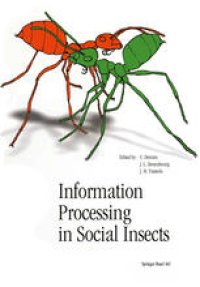
Ebook: Information Processing in Social Insects
- Tags: Life Sciences general, Biomedicine general
- Year: 1999
- Publisher: Birkhäuser Basel
- Edition: 1
- Language: English
- pdf
Claire Detrain, Jean-Louis Deneubourg and Jacques Pasteels Studies on insects have been pioneering in major fields of modern biology. In the 1970 s, research on pheromonal communication in insects gave birth to the dis cipline of chemical ecology and provided a scientific frame to extend this approach to other animal groups. In the 1980 s, the theory of kin selection, which was initially formulated by Hamilton to explain the rise of eusociality in insects, exploded into a field of research on its own and found applications in the under standing of community structures including vertebrate ones. In the same manner, recent studies, which decipher the collective behaviour of insect societies, might be now setting the stage for the elucidation of information processing in animals. Classically, problem solving is assumed to rely on the knowledge of a central unit which must take decisions and collect all pertinent information. However, an alternative method is extensively used in nature: problems can be collectively solved through the behaviour of individuals, which interact with each other and with the environment. The management of information, which is a major issue of animal behaviour, is interesting to study in a social life context, as it raises addi tional questions about conflict-cooperation trade-oft's. Insect societies have proven particularly open to experimental analysis: one can easily assemble or disassemble them and place them in controllable situations in the laboratory.
The book provides a first comprehensive overview of both experimental and theoretical research on information processing in insect societies. Its purpose is to make the reader familiar with the methodology and ways of thinking followed by scientists at the leading edge of the field.
The book is aimed at postgraduate students and researchers working on social insects and insects that live in groups as well as any reader interested in behavioural ecology, communication and social organization.
The book provides a first comprehensive overview of both experimental and theoretical research on information processing in insect societies. Its purpose is to make the reader familiar with the methodology and ways of thinking followed by scientists at the leading edge of the field.
The book is aimed at postgraduate students and researchers working on social insects and insects that live in groups as well as any reader interested in behavioural ecology, communication and social organization.
Content:
Front Matter....Pages I-XIV
Front Matter....Pages 1-1
Group size, productivity, and information flow in social wasps....Pages 3-30
Task partitioning in foraging: general principles, efficiency and information reliability of queueing delays....Pages 31-50
Interaction patterns and task allocation in ant colonies....Pages 51-67
Information flow during social feeding in ant societies....Pages 69-81
Models of information flow in ant foraging: the benefits of both attractive and repulsive signals....Pages 83-100
Information flow in the social domain: how individuals decide what to do next....Pages 101-112
Front Matter....Pages 113-113
Response thresholds and division of labor in insect colonies....Pages 115-139
Role and variability of response thresholds in the regulation of division of labor in insect societies....Pages 141-163
Social control of division of labor in honey bee colonies....Pages 165-186
Genetic, developmental, and environmental determinants of honey bee foraging behavior....Pages 187-202
Behavioral threshold variability: costs and benefits in insect societies....Pages 203-215
Front Matter....Pages 217-217
Individuality and colonial identity in ants: the emergence of the social representation concept....Pages 219-237
Key individuals and the organisation of labor in ants....Pages 239-259
Temporal information in social insects....Pages 261-275
The individual at the core of information management....Pages 277-286
Front Matter....Pages 287-287
Activity cycles in ant colonies: worker interactions and decentralized control....Pages 289-307
The mechanisms and rules of coordinated building in social insects....Pages 309-330
Decision-making in foraging by social insects....Pages 331-354
The mystery of swarming honeybees: from individual behaviors to collective decisions....Pages 355-378
Collective behavior in social caterpillars....Pages 379-400
Back Matter....Pages 409-415
Self-organization or individual complexity: a false dilemma or a true complementarity?....Pages 401-407
The book provides a first comprehensive overview of both experimental and theoretical research on information processing in insect societies. Its purpose is to make the reader familiar with the methodology and ways of thinking followed by scientists at the leading edge of the field.
The book is aimed at postgraduate students and researchers working on social insects and insects that live in groups as well as any reader interested in behavioural ecology, communication and social organization.
Content:
Front Matter....Pages I-XIV
Front Matter....Pages 1-1
Group size, productivity, and information flow in social wasps....Pages 3-30
Task partitioning in foraging: general principles, efficiency and information reliability of queueing delays....Pages 31-50
Interaction patterns and task allocation in ant colonies....Pages 51-67
Information flow during social feeding in ant societies....Pages 69-81
Models of information flow in ant foraging: the benefits of both attractive and repulsive signals....Pages 83-100
Information flow in the social domain: how individuals decide what to do next....Pages 101-112
Front Matter....Pages 113-113
Response thresholds and division of labor in insect colonies....Pages 115-139
Role and variability of response thresholds in the regulation of division of labor in insect societies....Pages 141-163
Social control of division of labor in honey bee colonies....Pages 165-186
Genetic, developmental, and environmental determinants of honey bee foraging behavior....Pages 187-202
Behavioral threshold variability: costs and benefits in insect societies....Pages 203-215
Front Matter....Pages 217-217
Individuality and colonial identity in ants: the emergence of the social representation concept....Pages 219-237
Key individuals and the organisation of labor in ants....Pages 239-259
Temporal information in social insects....Pages 261-275
The individual at the core of information management....Pages 277-286
Front Matter....Pages 287-287
Activity cycles in ant colonies: worker interactions and decentralized control....Pages 289-307
The mechanisms and rules of coordinated building in social insects....Pages 309-330
Decision-making in foraging by social insects....Pages 331-354
The mystery of swarming honeybees: from individual behaviors to collective decisions....Pages 355-378
Collective behavior in social caterpillars....Pages 379-400
Back Matter....Pages 409-415
Self-organization or individual complexity: a false dilemma or a true complementarity?....Pages 401-407
....